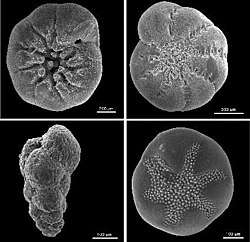δ13C
In geochemistry, paleoclimatology, and paleoceanography δ13C (pronounced "delta c thirteen") is an isotopic signature, a measure of the ratio of stable isotopes 13C : 12C, reported in parts per thousand (per mil, ‰).[1] The measure is also widely used in archaeology for the reconstruction of past diets, particularly to see if marine foods or certain types of plants were consumed [2]

The definition is, in per mil:
- ‰
where the standard is an established reference material.
δ13C varies in time as a function of productivity, the signature of the inorganic source, organic carbon burial, and vegetation type. Biological processes preferentially take up the lower mass isotope through kinetic fractionation. However some abiotic processes do the same, methane from hydrothermal vents can be depleted by up to 50%.[3]
Reference standard
The standard established for carbon-13 work was the Pee Dee Belemnite (PDB) and was based on a Cretaceous marine fossil, Belemnitella americana, which was from the Peedee Formation in South Carolina. This material had an anomalously high 13C:12C ratio (0.01118), and was established as δ13C value of zero. Since the original PDB specimen is no longer available, its 13C:12C ratio is currently back-calculated from a widely measured carbonate standard NBS-19, which has a δ13C value of +1.95‰.[4] The 13C:12C ratio of NBS-19 is .[5] Therefore, the correct 13C:12C ratio of PDB derived from NBS-19 should be . Note that there is a widely used but incorrect PDB 13C:12C ratio of 0.0112372, which is the result of a sign error in the interconversion between standards. Use of the PDB standard gives most natural material a negative δ13C.[6] A material with a ratio of 0.010743 for example would have a δ13C value of –39‰ from . The standards are used for verifying the accuracy of mass spectroscopy; as isotope studies became more common, the demand for the standard exhausted the supply. Other standards calibrated to the same ratio, including one known as VPDB (for "Vienna PDB"), have replaced the original.[7] The 13C:12C ratio for VPDB, which the International Atomic Energy Agency (IAEA) defines as δ13C value of zero is 0.01123720.[8]
Causes of δ13C variations
Methane has a very light δ13C signature: biogenic methane of −60‰, thermogenic methane −40‰. The release of large amounts of methane clathrate can impact on global δ13C values, as at the Paleocene–Eocene Thermal Maximum.[9]
More commonly, the ratio is affected by variations in primary productivity and organic burial. Organisms preferentially take up light 12C, and have a δ13C signature of about −25‰, depending on their metabolic pathway. Therefore, an increase in δ13C in marine fossils is indicative of an increase in the abundance of vegetation.
An increase in primary productivity causes a corresponding rise in δ13C values as more 12C is locked up in plants. This signal is also a function of the amount of carbon burial; when organic carbon is buried, more 12C is locked out of the system in sediments than the background ratio.
Geologic significance of δ13C excursions
C3 and C4 plants have different signatures, allowing the abundance of C4 grasses to be detected through time in the δ13C record.[10] Whereas C4 plants have a δ13C of −16 to −10‰, C3 plants have a δ13C of −33 to −24‰.[11]
Mass extinctions are often marked by a negative δ13C anomaly thought to represent a decrease in primary productivity and release of plant-based carbon.
The evolution of large land plants in the late Devonian led to increased organic carbon burial and consequently a rise in δ13C.[12]
References
- Libes, Susan M. (1992). Introduction to Marine Biogeochemistry, 1st edition. New York: Wiley.
- Schwarcz, Henry P.; Schoeninger, Margaret J. (1991). "Stable isotope analyses in human nutritional ecology". American Journal of Physical Anthropology. 34 (S13): 283–321. doi:10.1002/ajpa.1330340613.
- McDermott, J.M., Seewald, J.S., German, C.R. and Sylva, S.P., 2015. Pathways for abiotic organic synthesis at submarine hydrothermal fields. Proceedings of the National Academy of Sciences, 112(25), pp.7668–7672.
- Brand, Willi A.; Coplen, Tyler B.; Vogl, Jochen; Rosner, Martin; Prohaska, Thomas (2014-03-20). "Assessment of international reference materials for isotope-ratio analysis (IUPAC Technical Report)". Pure and Applied Chemistry. 86 (3): 425–467. doi:10.1515/pac-2013-1023. hdl:11858/00-001M-0000-0023-C6D8-8. ISSN 1365-3075.
- Meija, Juris; Coplen, Tyler B.; Berglund, Michael; Brand, Willi A.; De Bièvre, Paul; Gröning, Manfred; Holden, Norman E.; Irrgeher, Johanna; Loss, Robert D. (2016-01-01). "Isotopic compositions of the elements 2013 (IUPAC Technical Report)". Pure and Applied Chemistry. 88 (3): 293–306. doi:10.1515/pac-2015-0503. ISSN 1365-3075.
- http://www.uga.edu/sisbl/stable.html#calib Overview of Stable Isotope Research – The Stable Isotope/Soil Biology Laboratory of the University of Georgia Institute of Ecology
- Miller & Wheeler, Biological Oceanography, p. 186.
- www-pub.iaea.org/MTCD/publications/PDF/te_825_prn.pdf
- Panchuk, K.; Ridgwell, A.; Kump, L.R. (2008). "Sedimentary response to Paleocene-Eocene Thermal Maximum carbon release: A model-data comparison". Geology. 36 (4): 315–318. Bibcode:2008Geo....36..315P. doi:10.1130/G24474A.1.
- Retallack, G.J. (2001). "Cenozoic Expansion of Grasslands and Climatic Cooling". The Journal of Geology. 109 (4): 407–426. Bibcode:2001JG....109..407R. doi:10.1086/320791.
- O'Leary, M. H. (1988). "Carbon Isotopes in Photosynthesis". BioScience. 38 (5): 328–336. doi:10.2307/1310735. JSTOR 1310735.
- http://www.lpi.usra.edu/meetings/impact2000/pdf/3072.pdf
Further reading
- Miller, Charles B.; Patricia A. Miller (2012) [2003]. Biological Oceanography (2nd ed.). Oxford: John Wiley & Sons. ISBN 978-1-4443-3301-5.
- Mook, W. G., & Tan, F. C. (1991). Stable carbon isotopes in rivers and estuaries. Biogeochemistry of major world rivers, 42, 245–264.